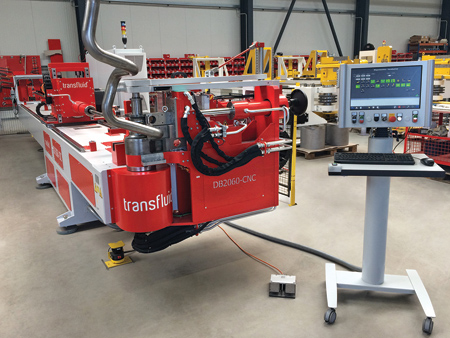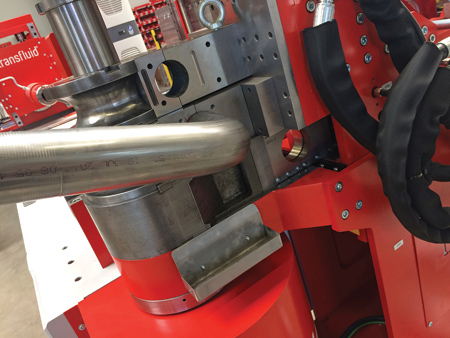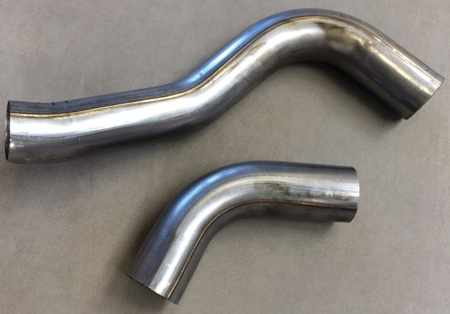
A system developed by transfluid for a current project enables the processing of tubes of up to 60 mm with a bending radius of 1 x D.

The tubes are initially bent in sequence and then cut with blades.

Two blades ensure an especially clean cut.
With the right machines and use of robots, transfluid offers economical production of short exhaust tubes with compact bending geometry.
"Cutting tubes is an art," said a company spokesperson. "A process is especially valuable if it avoids scrap and makes the immediately following process possible. For example, in exhaust technology in the automotive industry (at least when engine manifolds are involved), short tubes are frequently required, which feature numerous bends in short sequence. Of course, there is always the option to bend previously cut parts. However, it is often the case that workpieces are cut on one side or both sides and, under some circumstances, also need to be shaped."
transfluid provides a solution for this, as General Manager Stefanie Flaeper explained, "Depending on the requirements, our portfolio combines machines to create systems that are able to be loaded with tube lengths. The tubes are initially bent and then cut with blades. The special feature in this case is that this process is completed on the level of the bending machine and therefore enables scrap to be eliminated completely or extremely reduced." The tubes are therefore able to be cut to their final length. Depending on the pipe size, the separating cut runs from 2 to 3 mm. "In terms of commercial efficiency, this is a value creating alternative production option, especially in case of bending parts with relatively numerous bends," said Flaeper.
Diverse and Clean Cutting
Depending on the application, the different ways of cutting ensure that optimized results are able to be achieved. Especially in case of larger tubes in the exhaust area of large motor vehicles, e.g. with 127 mm diameter, it may be sensible to use only one blade to cut, even if a small deformation results in the outer diameter. In particular, this does not play any role if shaping or calibration is still required on this tube end. "A significantly cleaner cut results if two blades are used for cutting. This has the advantage that no deformation occurs on the pipe. This produces an absolutely straight separating cut," said Flaeper. Shaping can also be applied here directly. In the case of smaller tubes, this approach is usually better, since possible deformation toward the inside does not enable corresponding shaping tools to be used. The diameter is usually too small in this case.
Practical Experience-Systems and Robotics
A system developed by transfluid for a current project enables the processing of tubes of up to 60 mm with a bending radius of 1 x D. Most of the tubes produced in this case feature two or three bends, with the cut made straight after the last bend. No additional follow-up cuts are required. The bending machine for this solution features a center-line booster and three bending planes, plus the plane where the cutting tool is used.
An additional system can now process tubes up to a diameter of 60 mm in practical applications. The features of the machine are very similar to those mentioned previously. However, in this case the handling is executed in full by four robots. The machines are designed so that all of the tools are interchangeable and shared. This system is able to produce a set of tubes for an engine manifold, consisting of four different tubes, without the need for follow-up cutting. Next, a robot supplies the tubes immediately to the final processing step. This system component shapes the tubes asymmetrically so that they may be welded to the motor flange compactly in a separate work process. Finally, the handling robots take over again, which provide one kit each to the following welding robot. Both systems complete the cutting process with two cuts, since a good cut is required for the best possible resulting product.
transfluid manufactures tube bending and tube processing machines and provides customer-oriented, tailor-made solutions for plant and machine construction, the automotive and energy industries, shipbuilding and medical device manufacturers.
For more information contact:
transfluid Maschinenbau GmbH
sales@transfluid.de
www.transfluid.net